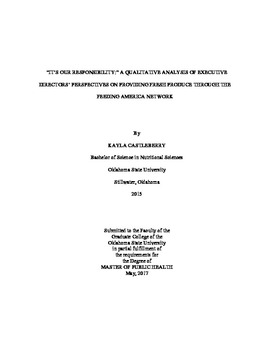| dc.description.abstract | Introduction- Food insecurity is a prevalent problem in the United States and is associated with increased risk of diet-related chronic diseases and poor nutritional status (Coleman-Jensen, Rabbitt, et al., 2016; Seligman, Laraia, & Kushel, 2010). Food banks, which distribute food to food insecure individuals, have the opportunity to address health but experience barriers attaining donor support or cold storage capacity and often do not distribute nutritionally balanced food (Akobundu, Cohen, Laus, Schulte, & Soussloff, 2004; Campbell, Ross, & Webb, 2013; Ross, Campbell, & Webb, 2013). Methods- This research is a secondary analysis of interviews with executive directors (EDs) of Feeding America food banks that have a low availability of fresh produce grown in their region. EDs were selected for maximum variation in their current resources and distribution of Foods to Encourage, a measurement of healthful foods. The pilot-tested, semi-structured question path addressed leadership attitudes on health promotion as well as barriers and opportunities to providing fresh produce in their food banks. Interviews were coded and common themes analyzed by food bank distribution of Foods to Encourage.Results- Low availability food banks experienced problems distributing healthful foods due to budget restrictions, regional variation in fresh produce growth, and partner agency cold storage capacity. Opportunities for future programs or current programs primarily included distribution or planning strategies. Partnerships with healthcare organizations to attain grant funding or to distribute healthful foods at a healthcare facility were cited particularly often. Leadership attitudes varied by current healthful food distribution, with high distributors exhibiting a passion and feeling responsibility for promoting health. Conclusions- In order to be resilient against the crisis of poor health in the food insecure community, food banks must exhibit good planning practices through training low distributing food banks and partnering with the healthcare community. A major component of intervention development will be in improving ED attitudes towards promoting health in order to direct nutrition policy change on the food bank level. | |
